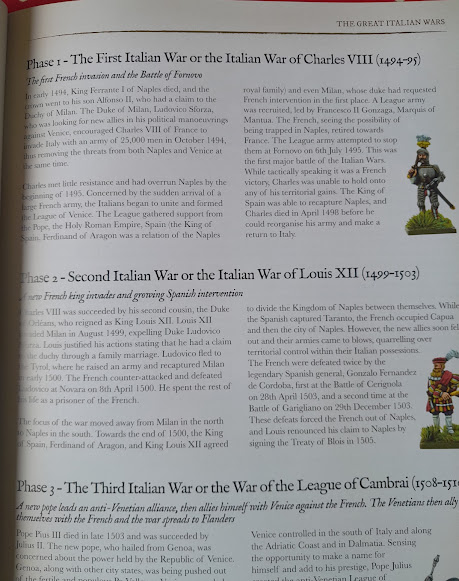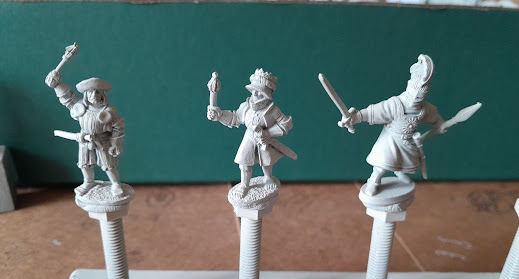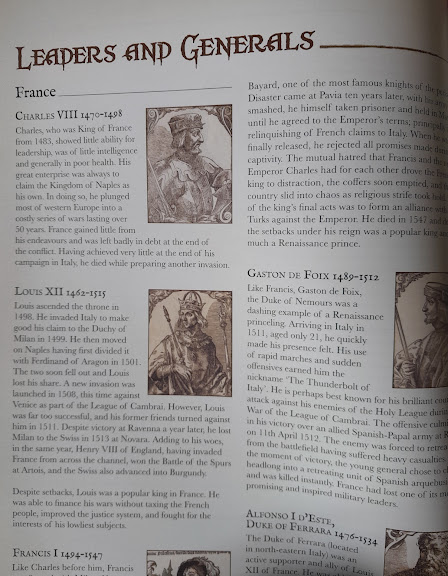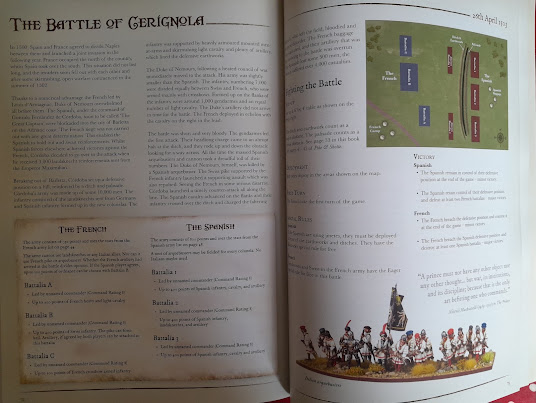I've purchased Warlord Games' new Pike and Shotte supplement, 'Death and the Landsknecht', as well as their new command figures. So, I thought that I ought to do a quick review of the supplement.
Now, I don't use Pike and Shotte for either of my Renaissance projects (Great Italian Wars and the French Wars of Religion). Nonetheless, I was interested to see what they might include and whether there was any potential use I could make of this tome.
First up, it is sensibly organised with the following 'chapters':
A history
The troops and weapons
Leaders and generals
Special rules
The army lists
Scenarios
Rules for gaming sieges
A campaign to play
Further reading
The history section is an appetite whetter. It is helpfully concise to quickly acquire the ebb and flow of the wars. At the same time, it doesn't fall into the trap of being weighed down by the numerous twists and turns. It gives enough. The assumption (I think) is that you either know the period and that's why you want the book, or you are new and excited about period and will follow up later with more detailed reading.
 |
| A sample of the history section. |
I think the theme of giving 'enough' information without getting too bogged down in detail continues throughout. It is certainly true in the troops and weapons section. It mentions all the troop types a gamer might wish to represent, along with their 'tools' of the trade.
The leader section is handy and short. When reading one history of the wars, I compiled a list and got around 60 leaders and generals before I stopped. This is far more select. One drawback is that its focus seems to be on the period up to around 1525... so, Pavia and just after.
I found the special rules section drew my attention. It included some useful information on the different formations, such as the Spanish Colunela, and how to simulate them in Pike and Shotte. If you are unfamiliar with the formations then this is a good starter. I enjoyed this part.
The army lists are interesting to read too. I don't use these rules. Nor do I use army lists. However, I can see how I might adapt and use these for creating 'balanced' fictional encounters if I was minded to.
What was very pleasing was that lists were included for the Peasant Wars, English, Scots and the Ottoman Turks as well. The latter opens up using your Venetian and/or Imperial armies in the Balkans.
The scenarios are a nice mix of battles. Again, the focus being pre-Pavia. Possibly because it was increasingly sieges thereafter, and possibly to avoid straying into battles in the wider Habsburg-Valois wars. Who knows?
The OOBs are obviously designed on a points basis to fit with the rules and this supplement. So, if you are looking for detailed orbats you will be disappointed. Each vanguard, battle and rearguard is given a points allocation and a sense of the troop types you should 'buy'. The exact composition is down to you. This has an advantage of allowing gamers to select to match their collection.
There is a helpful section on playing siege games. Whilst geared to to the rules they could give ideas to those looking to explore this area of the conflict. For me, I have neither the models, space to store, nor the current inclination to dabble in siegecraft.
Lastly, comes the campaign. The authors have set it around Milan circa 1515. This kind of fits in with the general focus of the supplement. It reads okay. In very simple terms it's a two player game (they say two teams or sides). You dice to see how many battles in a campaign season and of what type. These are played and then renown is earned at the end of each season. Depending on results, players can gain a various numbers of towns. Armies can be worn down over a number of seasons. Victory goes to the side that either captures all the towns, has the most towns after a certain number of seasons, or one side is too worn down to continue. There's more to it than this quick description suggests and it requires my closer inspection.

Last thoughts
I did hesitate about purchasing this. I couldn't see how it would add anything to my understanding of the period that I hadn't acquired through other sources and from Helion's "All is Lost Save Honour". Nor am I a player of Warlord Games' Pike and Shotte rules. However, I was pleasantly surprised at how much I enjoyed seeing how the supplement translated troops and formations of the period to their rules. It is a nice book to look at - as you might expect. Plus, having someone's take on scenarios and armies is interesting and may come in useful at a later date.
If you know a lot about these wars and don't use Pike and Shotte then this may not be useful other than expensive eye candy. Moreover, there isn't much for those interested in the wars after 1525.
I also purchased some command figures at the same time. All now prepped and awaiting some colour.
 |
| Some other Warlord Games command purchased at the same time: (L to R)Old Emperor Maximillian; Young "Max"; and the freebie with the supplement, Richard de la Pole - the last Yorkist claimant to the English throne and leader of the Landsknecht Black Bands at Pavia. |
 |
| These are new command figures from Warlord Games: Bartolomeo D'Alviano; Gaston de la Foix; and Giovanni de Medici of the Black Bands. All of them plastic. I don't know if Warlord have changed their "recipe" but the plastic is different from previously and have an hard rubber feel when trimming. |
In short, I'm glad that I bought the supplement but it won't be an essential asset. Please bear in mind that this is my view. Others may see things differently.













Useful review, Richard. Like you, I often find something of interest even in these rules-specific books even if I do not play the rules. I never buy based upon pretty photos. Organization is always interesting regardless of ruleset. Which scenarios are included and how do they compare with the Cairns and Ashton Wargamer's Guide?
ReplyDeleteThe scenarios included are: Fornovo; Dornach; Cerignola; Agnadello; Ravenna; Novara; Flodden; Marignano; Bococca; and the siege of Brescia. The last one helpfully included to compliment their siege rules section, which seems quite helpful with sensible ideas about sapping and mining for example.
DeleteThese scenarios are designed for play on 6 x 4 tables compared to Cairns and Ashton's 8 x 6. Certainly, the former is more accessible for us with only dining table space. However, dimensions could be shifted up and down depending on scale and rules used. Cairns and Ashton are more precise in naming and deploying specific troop types. Whereas the supplement assigns a total points to an army then allows the player to spend the points up to a certain amount in each battalia, e.g. a French army may have 800 points and can spend up to 400 on the vanguard, up to 400 on the main battle and up to 400 on the rearguard. There is also a little guidance on the troops you have to buy in each battalia, e.g. up to 400 points on light cavalry, French infantry and artillery. The proportions being the player's choice. This is good for those with more limited collections and saves having to buy and paint units for a particular scenario. However, if you want more "historical" precision then Cairns and Ashton may be for you. I'm avoiding talking about other publications such as Sides.
Cairns and Ashton has more scenarios: Fornovo; Cerignola; Garigliano; Agnadello; Ravenna; Novara; Marignano; Bicocca; Romagnano; Pavia; Gavinana; Ceresole; Scannagallo; St. Quentin; and Gravelines. In comparison to the supplement C & A deal with battles beyond Pavia, 1525.
Hope that helps Jonathan.
Yep! That helps a lot. Thank you!
DeleteI think sometimes a 'summary' from another rulebook can help clarify your own thinking on a period, even if you have no use for the rules themselves.
ReplyDeleteIt was a good confirmation of the decisions that I had already made.
DeleteI was going to write what Lee said. It is a good idea to get as many perspectives as possible and like you said I'm sure there were a few ideas that you'll consider adding in to your rules.
DeleteA good review Richard and it certainly looks to be a good primer for the period, without getting too bogged down in detail, losing the wood for the trees as it were! Not a period I'm ever likely to game, but you never know...
ReplyDeleteThanks Steve. It gives enough to give someone interested a start in something they are interested in without being daunted by the detail, technical terms and period names all coming at the reader at once.
DeleteInteresting review Richard. I might add it to my list next time I purchase something from them. It seems to be a nice potted summary given the ground it covers.
ReplyDeleteYou're welcome Lawrence.
DeleteUseful review Richard, may pick up a copy
ReplyDeleteThanks Neil. I hope that you are not disappointed.
DeleteSounds interesting especially as I do play pike and shot for this period, I am a little resistant to new spends, especially as I've had a bit of a splurge recently! The Helion book looks really good too, I have to say. It's worth looking on Olicanalad's blog as he was going to write the pike and shot supplement for Warlord at one point but the fact he plays piquet for the period probably undermines his authority I guess? Worth reading for his organisation of the Spanish colunna , my basing is taken from his for this period, there's loads worth going through for this period. I think your figures are resin, which Warlord are doing instead of metal these days, not my favourite but not bad!
ReplyDeleteBest Iain
Thanks Iain. It may be of interest to you then. However, I suspect that already have all your "special" rules and formations sorted.
DeleteI was expecting metal figures. The two Maximilians are metal but the new ones are resin. I don't mind plastic but these had an old feel to the touch.
Bothe the Warlord book and their figures look really nice Richard - a good purchase. Looking forward to seeing you splash some paint on the commanders!
ReplyDeleteThanks Keith. I hope that the final application looks better than a splash... we'll see and I'll let you be the judge.
DeleteGlad you like the book, Richard. You know I'm happy with it - as a P&S gamer. BTW, I only ordered the Gaston Foix figure because he looked pretty cool with the big hair. However, I found the horses legs a bit short. I may have to do some surgery on the legs, or at least base him up a bit for height.
ReplyDeleteThanks Dean. I did notice that, by eye, the ratio size of rider to horse looked a bit wrong. Few if any will notice that once in battle.
DeleteGreat review. I am like you- I don't play P&S. I had been trying to decide to splash out on it...even if it is expensive eye candy! I probably will now! Thank you!
ReplyDeleteThank you John. I hope you find it useful.
Delete